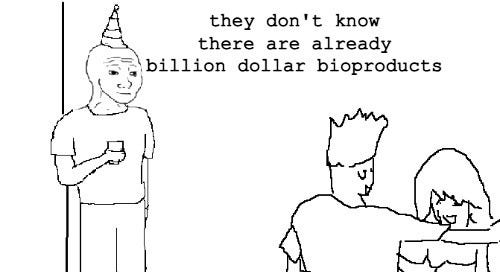The industrial biotechnology industry has the potential to transform chemicals manufacturing and be the next great lever in man’s quest for a life of abundance. At Biosphere, we’re working on unleashing biotechnology’s potential through innovation on manufacturing technology.
But it’s an industry that is littered with company failures. If you’re a startup employee, investor, or scientist it might feel like nothing is working - Zymergen and Amyris imploded, products have failed to scale, hype and hot air with seemingly little to show for it.
But just beneath the surface are a huge number of products in massive markets generating billions of dollars of revenue… they just happen to be made by companies you might not have heard of, like Novonesis, CJBio, and Hongda.
We hope this piece can serve as a nice reference point when people say “synbio has failed, where are the real products?”
Enzymes: $8-10b
Enzymes are made using fermentation, many with Aspergillus Niger, as well as a wide range of additional hosts. Novozymes (now Novonesis after merging with CHR Hansen) is a clear leader in the space with revenue of ~$3b in 2022. These include three billion dollar product classes:
Proteases: enzymes used to break down proteins, with applications in consumer laundry detergents, food processing (meat tenderizing, hydrolysis), wastewater management, and animal feed.
Chymosins: another type of protease used specifically in milk and dairy processing and found in pretty much all cheese manufacturing.
Glucoamylase: breaks down starch and other sugars. It’s used in the production of soy sauce, sake, and a wide variety of other alcoholic beverages.
There is a long tail of smaller enzyme markets (>$100m each), many of which are growing quickly: Lipase (detergents & cleaning), Catalase (food & textiles), Phytase (animal feed), and Alpha Amylase (high fructose corn syrup & ethanol).
Biomass: $10b
Products that are the microbes themselves. Less downstream processing required but also limited differentiation (unless you’re growing something truly novel). Each of these categories is > $1b in annual revenue.
Probiotics: microorganisms that provide health benefits when consumed, usually by improving or restoring the gut microbiota. Applications in animal health are also widespread.
Bakers yeast: Saccharomyces cerevisiae baby. Companies like Lesaffre, AB Vista, Lallemand, and Alltech make 100,000s of tons a year.
Biopesticides: the canonical example is Bacillus thuringiensis known as BT, which protects against insect pests. There are also various fungi that ward off bugs and protect against plant pathogens, as well as microbial isolates like pheromones and chitosan.
Food, feed, and cosmetic ingredients: $15-20b
The clear leader in food ingredients is Citric Acid ($5b), with more than 2 million tons made per year. It was previously isolated from citrus fruits, now exclusively fermentation derived - gives tart flavor to sodas, juices, teas, and is also used in cleaning and a wide range of industrial applications. Others include:
Amino Acids like Lysine ($3b) and Methionine ($2b). They are critical animal feed additives at greater than 1m ton/y scale.
MSG ($2b) the legendary flavor enhancer made using Corynebacterium species by market leaders like Ajinomoto.
Lactic Acid ($2b) is used as a natural food preservative and curing agent. It’s also a precursor for polymers and bioplastics.
Vitamin C ($1.5b) at > 100,000 tons per year, used as a food + dietary supplement (and almost exclusively made in China). Vitamin B12 ($500m), the most chemically complex vitamin, crucial for biological functions and must be sourced from our diets. It’s added to fortified flours and is especially important for vegans.
Xanthan Gum ($1b) a stabilizer and gelling agent used in sauces, ice cream, and toothpaste. It’s also widely used in the oil industry to thicken drilling mud!
Hyaluronic Acid ($1b), the grandaddy of bioproduced cosmetic ingredients. It used to be made from rooster combs, now exclusively produced by an engineered Bacillus. It’s a polysaccharide used as a humectant (water retainer) in topical applications for wound healing and serums/lotions/creams to reduce wrinkles. Also used as an injectable filler under brand names like Juvederm and Restylane.
Future billion dollar markets
We also see a wide range of up and coming new products with >$1b growth potential:
Collagen
Biosurfactants
Engineered probiotics
Human milk oligosaccharides
Dairy proteins
Sweeteners
High performance culinary oils
Bulk protein powders
Carotenoids
Omega-3 oils
Fish meal substitutes
Biopesticides
Biodegradable plastics
Diols
Sustainable aviation fuels
We’re scaling many of these at Biosphere, so get in touch if you want access to next generation biomanufacturing infrastructure to bring these products to market at far lower COGS.




love this 👍
Hey Arye!
Given your interest in Biotech, you might enjoy my recent piece on eXoZymes Inc. They’ve just commercially launched a cell-free enzyme biocatalysis platform that converts biofeedstocks into targeted chemical products.
Plus they just announced their first subsidary which synthesises N-trans-caffeoyltyramine (NCT) to treat MASLD/MASH. Very very interesting compound that has immense potential. A multiple billion market potential as there's no current treatment for MASLD.
https://www.slack-capital.com/p/exozymes-research-report